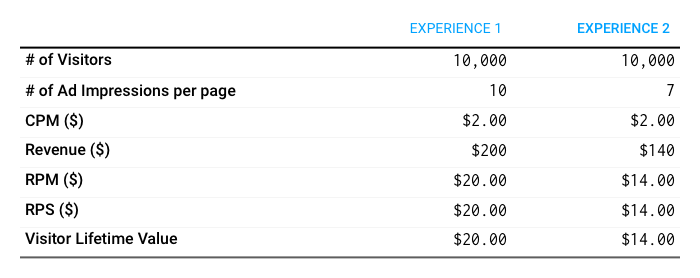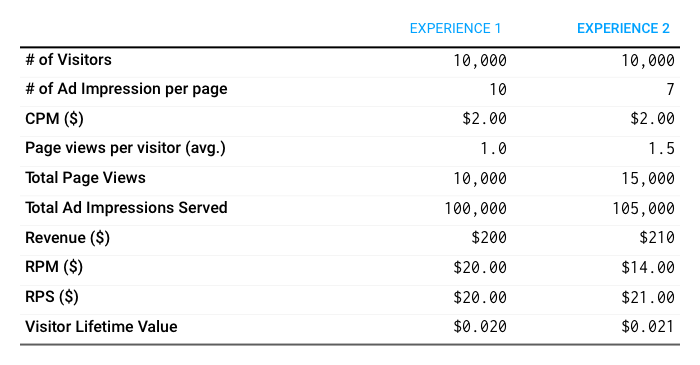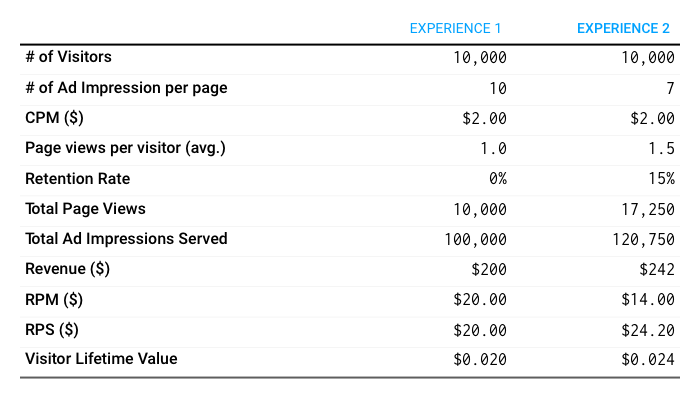Share this
How Faster Page Speeds Lead to Better Search Rank and More Revenue
by Tom Imboden on Dec 5, 2022 11:59:00 AM
Faster page speed performance leads to improvement in audience experience, as well as trust from Google. That's why faster sites are better at driving free traffic and incremental revenue for publishers.
The Revenue and Site Experience Balance
Similar to how parents balance screen time's impact on their children, publishers balance increasing advertising revenue's impact on audience experience.
—> Yes, more screen time /slash/ ads brings more parental productivity /slash/ publisher revenue, but at the grave risk of being "too much" — i.e. creating zombie children /slash/ churned-for-life audience.
The reality is there are two sides to the coin and revenue and monetization (often) conflict with creating the best possible user experience. More ads will create more revenue short term, but this poor brand experience opens the door to a myriad of downstream (and perhaps hard-to-track) effects, including negative audience growth, spiraling visitor retention, and traffic inconsistency.
Publishers looking for sustainable audience and revenue growth thus have to stay abreast of the critical tradeoff points that create more value for their businesses. That's why in this article let's learn why page speed matters so much — not just for users on-site, but also for the new ones yet to visit in the first place.
Why Does Page Speed Matter?
Page speed matters because, frankly, people don't spend time on slow.
The average adult attention span is around 12 seconds and roughly half that for teenagers. When pages load slowly, people "bounce" (i.e. leave a domain), which means publishers are neither showing their content nor earning money from ads, affiliate, direct, memberships, etc.
But the story doesn't stop there.
Page speed impacts user experience and search ranking. User experience, as we said, straightforward —> people, now more than ever, don’t like to wait. According to various research sources, 60%+ of consumers will leave a site if it takes longer than 3 seconds to load.
The connection between page speed and search ranking, however, is not as direct. That's because of Google Search, and the black box algorithm used to determine page rank. Though Alphabet (Google Search's parent company) does not transparently share exactly the way site speed factors into average search position ranking, the corporate tech giant consistently maintains that site speed is absolutely critical.
Speed is also a critical component of Core Web Vitals measurements, which Google incorporated into its search algorithm in 2021. While it’s not exactly clear how Google incorporates and weights what Core Web Vitals measure, what is clear is that Google does care about site speed — and that there is a direct connection between speed and revenue. Here's the value chain:"
- Better page speed —> improves overall search rankings —> better site ranking and discoverability —> more organic traffic —> more ad revenue @ zero cost of audience acquisition. Site speed enhances your ability to drive valuable organic traffic to your content, and, ultimately, more visitors from which you can earn revenue.
Let's consider through the lens of a use case:
Yes, a video programmatic ad slot increase short-term revenue. Programmatic advertisers pay more for video than they do for spots and dots. However, the analysis can't stop there. Heavier loads also affect page speed, which affects search engine rank, and thus traffic from other visitors.
Sustainable growth will only come from increasing the quality of ads, i.e. earning revenue while improving or maintaining the experience for visitors.
How Do Ads Impact Page Speed?
A lot! Clunky ad tech can slow a page down to the point that it loses its SEO trust from Google and rapidly declines in traffic.
The reason is the number of files that have to load on a page; the larger number of files, the longer it takes to load a page. Ads are effectively additional files, and each incremental ad unit increases a page’s weight and load time.
The Long View
Successful publishers focus on building long-term, sustainable revenue. It can be tempting to maximize the revenue earned during a single visit or page view with a high density of ads, but the goal should not be earning as much as possible from a single visit - it should be earning as much as possible from a single visitor over the course of their lifetime visits to your site.
To illustrate the importance of this thinking, let’s apply a very common marketing principle, Customer Lifetime Value, to a visitor coming to a publisher’s site. For our purposes, we’ll call it “Visitor Lifetime Value.”
In this exercise, we’ll compare two different page experiences as defined below:
- Experience 1: Maximizing monetization of a single visit with a highly-dense ad experience that causes slower page loads and a less favorable user experience.
- Visitors don’t like this experience and don’t want to return.
- Experience 2: Monetizing a single visit with a slightly more limited ad experience that emphasizes speed and performance.
- Users like this experience and are likely to come back.
By walking through three distinct scenarios, we can understand how to prioritize long-term success over short-term gains.
Scenario 1: The Value of the Initial Page View
In this initial scenario, we are just focusing on the initial page visit — there are no other factors at play. We’ll also assume that across both experiences, the site earns the same revenue for each ad slot (CPM).

In this first case, Experience 1 nets out ahead, which is not surprising: you’re serving more ads. RPM and RPS, as a result, are higher.
But what this doesn’t account for is whether Experience 1 is more likely to encourage a longer visit (session). Let’s layer in that assumption to see how it changes the above.
Scenario 2: The Value of the Session
Let’s assume that since Experience 1 is a much heavier ad experience, visitors basically come to just this one page and bounce off it right away. But in Experience 2, the user experience is more inviting and encourages additional engagement. As a result, the average visitor views 1.5 page views as opposed to just 1.0 as in Experience 1.

It’s pretty easy to see how incremental user engagement can drive additional value (and revenue). What’s interesting to note here is that RPM is unchanged - since the parameters around the number of ads on page and the amount each is earning (CPM) is unchanged, these rates will remain consistent. However, RPS is higher, since it measures the value of the sessions, and now each session is longer in Experience 2 (i.e. leading to more page views).
This is an important distinction to understand, as many ad:tech providers (and publishers) overly focus on maximizing RPMs, which can come at the detriment of long-term, sustainable revenue growth.
But this scenario is still incomplete because it ignores a critical element: retention (or generation of repeat visits).
Scenario 3: The Lifetime Visitor Value
Now, let's make an assumption that Experience 2 creates a 15% retention rate, i.e. 15% convert to an additional visit, whereas Experience 1 is a one-and-done experience —> how much does that impact Visitor Value?

You'll notice that Experience 2 now drives an increasingly higher visitor lifetime value than Experience 1.
How Can You Limit the Impact of Ads on Page Speed?
There are 5 ways that I can think of that almost any provider will mention:
- Header bidding
- Initialization Delays (“Footer Bidding”)
- Lazy loading
- Demand partner optimization
- Refresh tuning
Have others? Please reach out to me @ tom@organic.ly
Case in Point: Organic Ads vs. Leading AdTech Providers
 Data Source: Google Analytics
Data Source: Google Analytics
Note: Sites 1 and 2 were all measured during split tests against competitors for periods of 45-90 days with the exact same ad configurations. Sites 3 and 4 were measured as full-site comparisons of Organic Ads vs. the competitor over the prior period. In these cases, configurations differed, but in no case were fewer ads shown than with the competitor solution.
To learn more about Organic Ads, please visit Organic.ly/apps/organic-ads.
Research Sources
- https://crystallize.com/blog/this-is-how-much-site-speed-affects-google-seo-ranking-with-data
- https://www.searchenginejournal.com/ranking-factors/page-speed/#close
- https://www.ezoic.com/how-ads-affect-site-speed-scores/
- https://newormedia.com/blog/balancing-website-load-speed-with-ad-monetization/
Key Takeaway
Site speed matters — for a publisher's audience on-site currently, as well as for future audience earned via Google Search. Earning money from advertising sustainably requires using quality technology that takes visitor lifetime value into account.
The alternative is squeezing max cash out of every unique visit, which skyrockets acquisition cost, and rapidly increases cash burn —> every incremental visit has to come from someone new.
Looking for publisher SaaS that immediately improves site speed? Here are 7 ways that Organic improves site speed.
Share this
- June 2024 (2)
- May 2024 (3)
- April 2024 (1)
- March 2024 (4)
- February 2024 (1)
- January 2024 (11)
- December 2023 (1)
- November 2023 (2)
- October 2023 (3)
- September 2023 (3)
- August 2023 (4)
- June 2023 (1)
- May 2023 (3)
- March 2023 (4)
- February 2023 (5)
- January 2023 (3)
- December 2022 (1)
- November 2022 (2)
- October 2022 (2)
- September 2022 (1)
-3.png?width=1200&height=700&name=organic-ads-line-graph%20(1)-3.png)